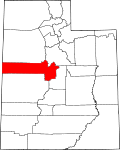 Welcome sign in Ibapah, Utah | |
| Total population | |
|---|---|
| 539 enrolled members [1] | |
| Regions with significant populations | |
| Languages | |
| Shoshoni language, English | |
| Religion | |
| Native American Church, The Church of Jesus Christ of Latter-day Saints [2] | |
| Related ethnic groups | |
| other Western Shoshone peoples, Ute people |
The Confederated Tribes of the Goshute Reservation is located in Juab County, Utah, Tooele County, Utah, and White Pine County, Nevada, United States. [3] It is one of two federally recognized tribes of Goshute people, the other being the Skull Valley Band of Goshute Indians of Utah.
Contents



